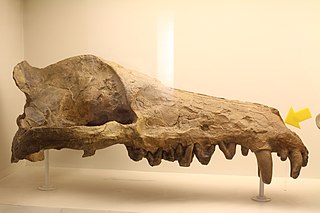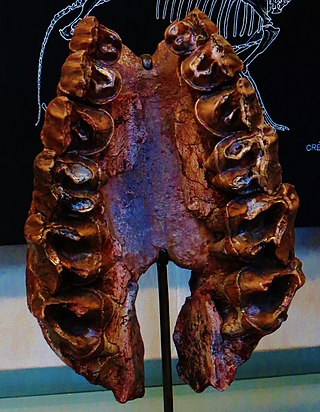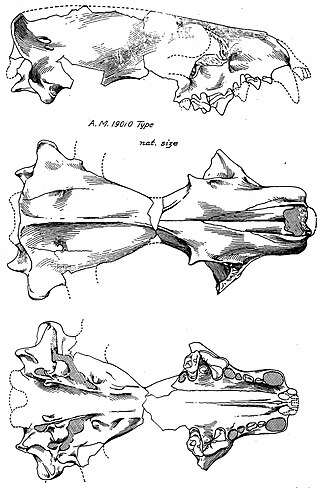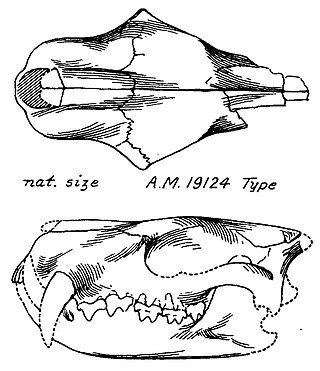Microcosmodon is a mammal genus from the Paleocene of North America. It was a member of the extinct order Multituberculata, and lies within the suborder Cimolodonta and family Microcosmodontidae. The genus Microcosmodon was named by G.L. Jepsen in 1930.

Andrewsarchus is an extinct genus of mammal that lived during the Middle Eocene in China. It contains two species, A. mongoliensis and A. crassum. It was formerly placed in the families Mesonychidae or Arctocyonidae, but is now the sole member of a distinct family, Andrewsarchidae. It is most notable for being estimated as the largest terrestrial, carnivorous mammal, but that status has been disputed.

Cynodictis is an extinct amphicyonid carnivoran which inhabited Eurasia from the Late Eocene subepoch to the Early Oligocene subepoch living from 37.2—28.4 million years ago, existing for approximately 8.8 million years.

Hyaenodon ("hyena-tooth") is an extinct genus of carnivorous placental mammals from extinct tribe Hyaenodontini within extinct subfamily Hyaenodontinae, that lived in Eurasia and North America from the middle Eocene, throughout the Oligocene, to the early Miocene.

Copepteryx is an extinct genus of flightless bird of the family Plotopteridae, endemic to Japan during the Oligocene living from 28.4 to 23 mya, meaning it existed for approximately 5.4 million years.
Brachyhyops is an extinct genus of entelodont artiodactyl mammal that lived during the Eocene Epoch of western North America and southeastern Asia. The first fossil remains of Brachyhyops are recorded from the late Eocene deposits of Beaver Divide in central Wyoming and discovered by paleontology crews from the Carnegie Museum of Natural History during the early 20th century. The type species, Brachyhyops wyomingensis, is based on a single skull and was named by E.H. Colbert in 1937, but was not officially described until 1938. During the latter half of the 20th century, additional specimens from North America have been recorded from Saskatchewan and as far south as Texas, indicating that Brachyhyops had a broad distribution and was well-dispersed throughout western North America.

Asiavorator is an extinct genus of civet-like carnivoran belonging in the family Stenoplesictidae. It was endemic to Asia and lived during the Eocene and Oligocene epochs.

The Jebel Qatrani Formation is a geologic formation located in the Faiyum Governorate of central Egypt. It is exposed between the Jebel Qatrani escarpment and the Qasr el Sagha escarpment, north of Birket Qarun lake near Faiyum. The formation conformably overlies the Qasr el Sagha Formation and is topped by the Widan el Faras Basalt. The age of the formation has been subject to debate, but the most recent research indicates that it covers both the latest parts of the Eocene and the Early Oligocene, spanning over the boundary between these two time periods.

Archiinocellia is an extinct genus of snakefly in the family Raphidiidae known from Eocene fossils found in western North America. The genus contains two species, the older Archiinocellia oligoneura and the younger Archiinocellia protomaculata. The type species is of Ypresian age and from the Horsefly Shales of British Columbia, while the younger species from the Lutetian Green River Formation in Colorado. Archiinocellia protomaculata was first described as Agulla protomaculata, and later moved to Archiinocellia.
Urtinotherium is an extinct genus of paracerathere mammals. It was a large animal that was closely related to Paraceratherium, and found in rocks dating from the Late Eocene to Early Oligocene period. The remains were first discovered in the Urtyn Obo region in Inner Mongolia, which the name Urtinotherium is based upon. Other referred specimens are from northern China.

The Hsanda Gol Formation is a geological formation located in the Tsagan Nor Basin of central Mongolia that dates to the Rupelian age of the Oligocene epoch. It formed in continental desert-like conditions and is notable for its fossil mammals, first excavated by Roy Chapman Andrews and the American Museum of Natural History in the 1920s. Hsanda Gol is included in the Hsandagolian Asian Land Mammal Age, to which it gives its name.

Ronzotherium is an extinct genus of perissodactyl mammal from the family Rhinocerotidae. The name derives from the hill of 'Ronzon', the French locality near Le Puy-en-Velay at which it was first discovered, and the Greek suffix 'therium' meaning 'beast'. At present 5 species have been identified from several localities in Europe and Asia, spanning the Late Eocene to Upper Oligocene.

Xenocranium is an extinct monotypic genus of placental mammal from extinct paraphyletic subfamily Epoicotheriinae within extinct paraphyletic family Epoicotheriidae in extinct order Palaeanodonta, that lived in North America during the late Eocene.
Pternoconius is an extinct genus of macraucheniid litoptern from the Late Oligocene and Early Miocene of Argentina. Fossils of this genus have been found in the Sarmiento Formation of Argentina.

Phocavis is an extinct genus of flightless seabird, belonging to the family Plotopteridae, and distantly related with modern cormorants. Its fossils, found in the Keasey Formation in Oregon, are dated from the Late Eocene.

Olympidytes is an extinct genus of Plotopteridae, a family of large, flightless marine bird superficially similar to modern penguins but more closely related to cormorants and gannets. It lived during the Late Eocene or the Early Oligocene, in what is today the State of Washington and Japan.

Amphicticeps is an extinct genus of small, weasel-like carnivoran mammal. It lived in Mongolia during the Oligocene. The genus was erected in 1924 for the species A. shackelfordi on the basis of a well-preserved skull. Historically, the systematic position of this genus has been problematic until more specimens were described decades later.
Alagtsavbaatar is an extinct species of carnivorous cat-like carnivoran belonging to the superfamily Aeluroidea. It was endemic to Asia, with all known specimens being found in Mongolia, and lived during the late Eocene epoch. It is a monotypic genus, with the type and only known species being A. indigenus, and is named after the Alag Tsav locality where its remains were first discovered.
The Ergilin Dzo Formation, is a geologic formation in southeastern Mongolia. It preserves fossils of a wide variety of animals, which date back to the late Eocene epoch. The type fauna of the Ergilian Asian land mammal age is defined by the mammalian fossils of this formation.

Didymoconus is an extinct genus of mammal that lived during the early Oligocene epoch. It was endemic to Asia, and its fossils have been found in Mongolia, China and Kazakhstan. It is the type genus of the Didymoconidae, a family of eutherian mammals with uncertain taxonomic affinities.













